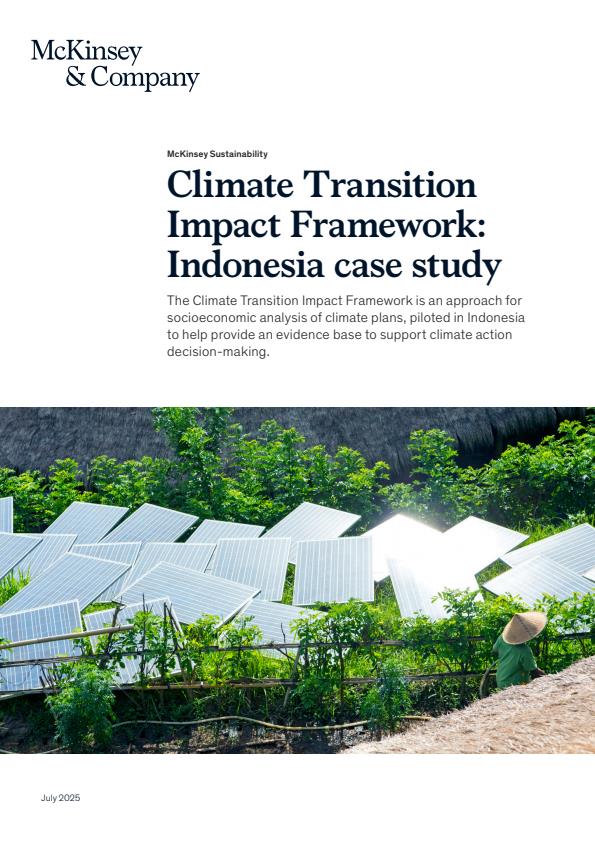Addressing the climate transition requires a new way of thinking. On the one hand, if the goal is net-zero emissions by 2050, the world is well short of meeting it.1 The United Nations has noted that there are big gaps between the targets that countries have committed to and the actions being taken to meet them.2 At the same time, there are real concerns that taking effective action could raise energy prices, increase job losses, and slow economic growth. A holistic approach that considers and contrasts the socioeconomic co-benefits and burdens of the climate transition is required to enable decision-makers to choose the optimal transition pathway.
To date, transition planning has focused on assessing marginal abatement cost curves and optimizing the economic cost of achieving goals in line with the Paris Agreement. The Climate Transition Impact Framework (C-TIF) proposes a structured, forward-looking approach to enable decision-makers to place people at the heart of climate action, explicitly considering socioeconomic impacts alongside mitigation, adaptation, and growth objectives. The framework has five dimensions: affordable energy access, lived environment and health, investment requirement, jobs impact, and growth and competitiveness. Together, they provide a holistic view of the socioeconomic impacts associated with chosen climate pathways to help decision-makers understand the trade-offs that may need to be considered throughout the transition.
Indonesia has announced official targets to become a high-income country by 2045 or earlier and to reach net-zero emissions by 2060. The government aims to encourage green growth, including by implementing several regulatory and fiscal incentives.3 Achieving Indonesia’s environmental and economic aspirations in an inclusive manner will require a thorough analysis of the existing transition pathways. Therefore, it will be critical to engage in careful transition planning that includes a comprehensive examination of socioeconomic metrics to understand the projected co-benefits and burdens of different climate pathways.4
Indonesia could help secure a green and sustainable future by identifying and acting on opportunities on the road to net zero. Indonesia will see significant opportunities emerge as it pursues its sustainable development goals. For example, the country has large reserves of nickel, a critical mineral in the electric-vehicle supply chain; untapped potential in the energy sector in renewables, such as geothermal, hydro, and sustainable fuels; potential to develop carbon capture and storage resources; and an abundance of natural capital, primed to deliver nature-based solutions and generate carbon market revenues. The transition to a low-carbon energy system could also allow Indonesia to reduce its dependence on fossil fuel imports.
The transition will also lead to burdens that must be carefully managed to ensure equitable outcomes from climate action. These burdens include increases in the delivered cost of electricity as the country begins to rely less on relatively inexpensive domestic fossil resources, with implications for economic competitiveness. There could be substantial shifts in the labor market as traditional employment centers in industry and power relocate to align with low-carbon energy opportunities. Further, the transition will require a significant increase in investment in low-emission technologies. For example, in the power sector alone, average annual investments in low-emission technologies are expected to total $17.9 billion per year—or 1.7 percent of GDP.
The illustrative C-TIF outputs presented in this report compare potential socioeconomic impacts for business-as-usual and net-zero scenarios derived from multiple in-country and governmental data sources with varying underlying assumptions (exhibit). This report consolidates these data sources to produce a view of C-TIF measures across both scenarios. While efforts have been made to reconcile sources where possible, there are naturally some inconsistencies in underlying assumptions among inputs. This underscores the need for countries to better understand the nuances of potential socioeconomic impacts and develop comprehensive transition plans based on integrated whole-economy scenarios.

Indonesia could consider reorienting its nationwide economic planning by putting people at the heart of climate action. Innovative blended-finance instruments, with international support, will be required to address the increased need for sizable investments in low-emission technologies. Capacity building and reskilling are needed to smooth the labor force transition—particularly for workers in transition-exposed industries—and reduce the near-term burden of labor market shifts. Further, calling attention to and amplifying the projected socioeconomic and lived-environment co-benefits of the net-zero transition could rally support for action. Decision-makers could also carefully consider the optimal sequencing of climate actions to help manage future costs—for example, by prioritizing the deployment of technologies that are already cost competitive, reducing overreliance on higher-cost measures, and spreading infrastructure investment needs across the transition, helping manage potential spikes in costs for consumers. Indonesia could also further refine its C-TIF outputs by conducting detailed, localized, and economy-wide transition planning across multiple scenarios. In this way, the country can generate a more granular and precise view of socioeconomic co-benefits and burdens and develop appropriate measures to manage them throughout the transition.


